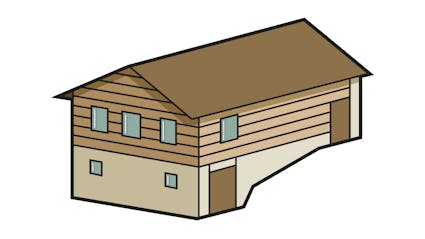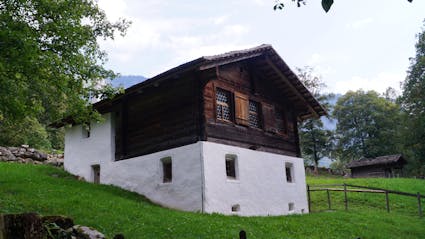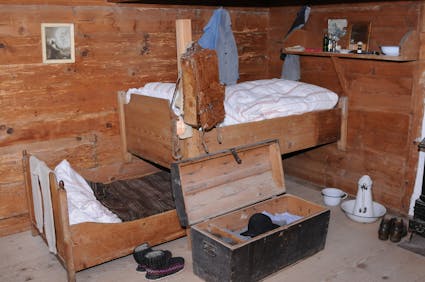1371 – "Maiensäss" House from Buochs, Nidwald, 1788
Spring camp houses (Maiensässe) are arranged analogously to village houses, just smaller and more compact.

Undated
Since the 16th century, dwellings have often been provided with an inscription. It gives the building date, the name of the owner, sometimes of the builder and is often accompanied by a devout motto or decoration.
Barns, stalls and storage buildings often remained unadorned. Up at the spring pastures and summer camps, the buildings were plainer than in the village, as exemplified by this house from “Unter Feld” near Buochs. The initials MHI and AST and the date 1722 carved into the window front probably refer to the builders and the building date. Rosettes like the one carved here appear here and there on the walls of spring camp and summer alp buildings.

Mountain Interval
Spring camp houses (Maiensässe) are arranged analogously to village houses, just smaller and more compact. Dwelling and workplace – everything is on hand but less elaborate. Parlour and bedroom are in the same room; a built-in bedstead with a retractable bed beneath it is usual. The standard kitchen equipment comprises a hearth with a swinging arm and a cheesemaking cauldron. The open smoke space exhausting right through the masonry rear wall is rare and seems antiquated in view of the building date. The milk cellar is on the ground floor; prominent slits provide the necessary ventilation – it is a so-called cooling cellar like that from Unterschächen (722). The stone foundation and the rear wall of the house (open hearth kitchen) are exceptionally large and with the singularly shaped opening dominate the overall impression of the house.

Nomads?
In the alpine and pre-alpine zones the various elevational stages were utilised in harmony with the rhythm of the seasons: farmers exploited the lowest farmlands in the springtime and then moved upward stage by stage to the high alpine summer pastures in tune with nature’s progress. Each stage was occupied for a few weeks. The farmers either ascended and descended daily between village and alp – or they had a hut at each stage of elevation. The Maiensäss, called in the dialect of Nidwald “ä Berg”, is one of these stations between village and mountain, seasonally occupied in the spring and autumn. Mountain farming families were often referred to in school books as nomads – which is not really true, since they do have a permanent home and only undertake their seasonal wanderings in the summer. Today most of these temporary quarters on alps and Maiensässe have been converted to vacation spots – or else the places are deserted and the buildings deteriorating.
Ballenberg
Swiss Open-Air Museum
Museumsstrasse 100
CH-3858 Hofstetten bei Brienz
Company holidays
24 December 2025 to 11 January 2026
Opening hours Administration
3 November 2025 to 8 April 2026
From Monday to Friday
8.30 am to 11.30 am
1.30 pm to 4.30 pm
Opening hours
9 April to 1 November 2026
10 am to 5 pm daily